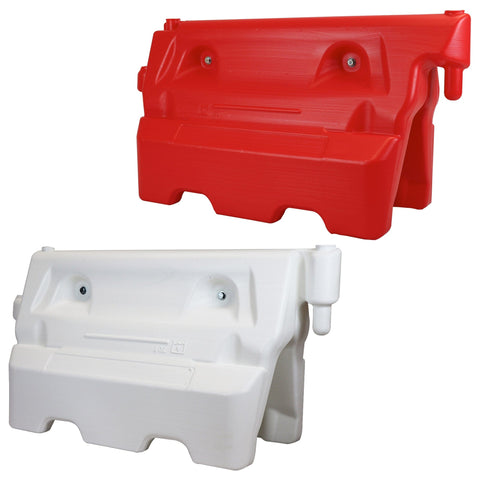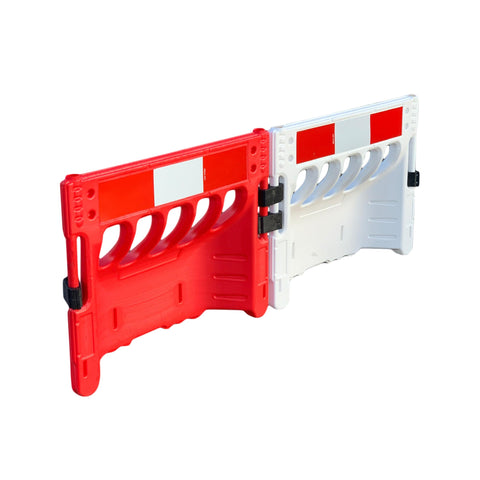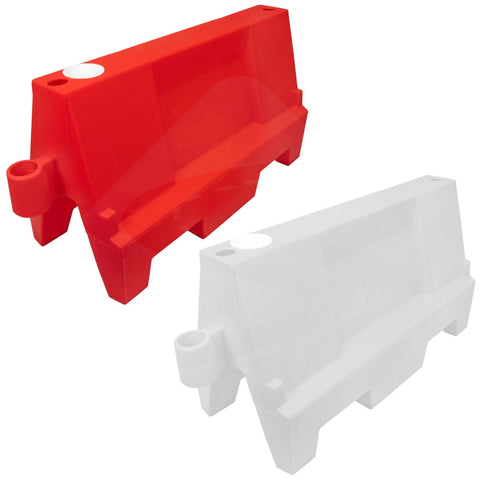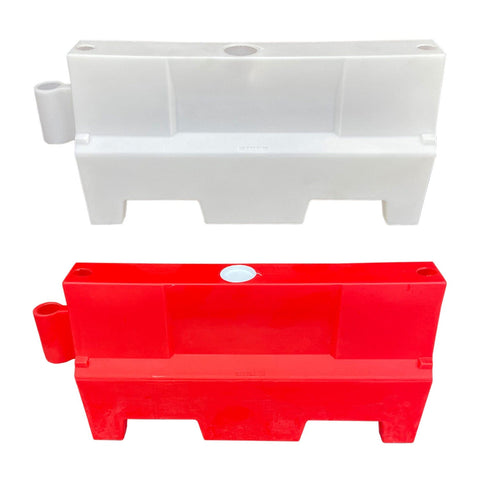Water Filled Barriers
Water-filled barriers are high-visibility safety barriers that are primarily used to protect pedestrians from slow-moving cars, vans and bikes. These barriers, which are made of tough plastic, provide a sturdy and reliable safety system that is quick and simple to set up.
Water Filled Barriers
At Street Solutions UK we offer an extensive range of water-filled safety barrier products for sale to suit a variety of site tasks, whether it’s a pedestrian barrier or road barrier that you need, we have everything to suit your requirements.
Water-filled safety barriers are made from plastic and are relatively lightweight making them easy to transport and deploy, either water or sand can be used to fill them, ensuring the barrier will not move from its position. A water barrier offers solid stability.
We also supply heavy duty water filled barriers manufactured with HVG’s in mind, these can be used on construction sites or logistic sites where lane delineation is needed and to create a strong barricade between vehicles and pedestrians. The GB2 barrier can withstand wind speeds of up to 78mph when filled with water to the fill line. From durable water barriers, road barriers, traffic barriers, we have it all.
Express delivery and bulk discounts available to buy. For more information on our products or to get a custom quote on larger orders please get in touch with our sales team on 0161 706 0479 or email us at sales@streetsolutionsuk.com (we also have a guide).
Frequently Asked Questions
Q: What is the purpose of water-filled barriers?
A: A water-filled plastic barrier with a traffic rating that is used for roadwork and traffic management. These water-filled barriers allow a striking vehicle to be safely and predictably stopped, contained, or redirected.
Q: What exactly are water barricades?
A: Water or sand-filled barricades/safety barriers are designed to be transported without the use of heavy-duty lifting equipment. Water or sand can be used to fill the barrier, making it an immovable object and fulfilling the objective of blocking access to specified perimeters.
Q: What are water barriers made of?
A: Water-resistant crash barriers are available in a variety of widths, lengths, and materials. These are polymeric-based sheets (plastic) that can be spun-bonded (fibres), cross-woven (tapes), film (sheets), or a combination of these.
Q: What are water-filled barriers?
A: Water-filled barriers are a type of traffic safety equipment used to separate vehicles or pedestrians from work zones, construction sites, or other hazards. They are made of a plastic material and can be filled with water to add weight and stability. A barrier with water filled ability offers extreme stability.
Q: What are the benefits of using water-filled barriers?
A: Water-filled barriers offer several benefits, including:
- They provide a physical barrier that can protect workers and equipment from passing vehicles like a plastic road barrier.
- They are portable and easy to move, making them ideal for temporary work zones.
- They are reusable and can be refilled with water, which makes them an environmentally-friendly choice.
- They are highly visible, which can help prevent accidents and improve overall safety.
Q: What types of water-filled barriers are available?
A: There are several types of water-filled barriers available, including:
- Jersey barriers: These are tall, rectangular barriers often used on highways and other high-speed roads.
- K-rail barriers: These are shorter, curved plastic barriers often used on lower-speed roads or in construction zones.
- Pedestrian barriers: These are shorter barriers designed to protect pedestrians in areas where vehicle traffic is present.
Q: How do you fill water-filled barriers?
A: Water-filled barriers can be filled using a hose or pump. There is typically a fill hole at the top of the barrier where water can be added. Once filled, the hole is sealed to prevent leaks.
Q: How much water do water-filled barriers hold?
A: The amount of water a barrier can hold depends on its size and shape. However, most barriers can hold between 200 and 400 gallons of water.
Q: Are water-filled barriers easy to transport?
A: Yes, water-filled barriers are designed to be portable and easy to transport like temporary barriers. They can be moved using a forklift or other heavy equipment, or they can be rolled into place using built-in wheels.
Q: How long do water-filled barriers last?
A: Water-filled barriers are designed to be durable and long-lasting. With proper maintenance and care, they can last for several years.
Q: Can water-filled barriers be customised?
A: Yes, Yes, water-filled plastic barriers can be customised with company logos or other branding. They can also be painted to match specific colours or patterns.





